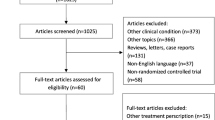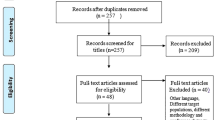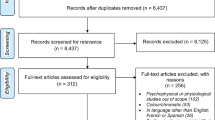Abstract
Purpose
To investigate the effects of Cambridge Stimulator with grating element stimulation on visual acuity (VA), grating acuity (GA), and contrast sensitivity (CS) in patients with amblyopia.
Methods
Three electronic databases (PubMed, Embase, and Cochrane Library) were searched for studies published from January 1970 to November 2022. The searched studies were reviewed and extracted independently by two authors. The included studies were evaluated by the Cochrane risk of bias. A meta-analysis calculating Hedges’ g effect-size metric with 95% confidence intervals using random-effects DerSimonian-Laird model was employed. Heterogeneity was estimated using I2 statistics. Outcomes of interest included VA, GA, and CS.
Results
A total of 1221 studies were identified. Twenty-four studies including 900 subjects met the inclusion criteria. The outcome measure of all visual indexes (VA: Hedges’ g of − 0.43, 95% CI = − 0.81 to − 0.05, I2 = 86%, p = 0.02; GA: Hedges’ g of 3.79, 95% CI = 1.05 to 6.54, I2 = 98%, p = 0.01; CS: Hedges’ g of 0.64, 95% CI = 0.19 to 1.09, I2 = 41%, p = 0.00) significantly favored in the grating group.
Conclusions
Grating stimulation may be a positive help for visual functions in patients with amblyopia. The effects of grating stimulation on VA and CS appear to be opposite. This study is registered with www.crd.york.ac.uk/prospero/ (CRD42022366259).




Similar content being viewed by others
Data availability
The original contributions presented in the study are included in the article/supplementary materials; further inquiries can be directed to the corresponding author/s.
References
Yeh WH, Lai LJ, Chang DW, Lin WS, Lin GM, Shaw FZ (2021) Portable rotating grating stimulation for anisometropic amblyopia with 6 months training. Sci Rep 11(1):11430. https://doi.org/10.1038/s41598-021-90936-7
Khalaj M, Zeidi IM, Gasemi MR, Keshtkar A (2011) The effect of amblyopia on educational activities of students aged 9–15. J Biomed Sci Eng 4(07):516. https://doi.org/10.4236/jbise.2011.47066
Webber AL (2018) The functional impact of amblyopia. Clin Exp Optom 101(4):443–450. https://doi.org/10.1111/cxo.12663
Campbell FW, Hess RF, Watson PG, Banks R (1978) Preliminary results of a physiologically based treatment of amblyopia. Br J Ophthalmol 62(11):748–755. https://doi.org/10.1136/bjo.62.11.748
Mehdorn E, Mattheus S, Schuppe A, Klein U, Kommerell G (1981) Treatment for amblyopia with rotating gratings and subsequent occlusion: a controlled study. Int Ophthalmol 3(3):161–166. https://doi.org/10.1007/BF00130699
Huang HM, Kuo HK, Fang PC, Lin HF, Lin PW, Lin SA (2008) The effects of CAM vision stimulator for bilateral amblyopia of different etiologies. Chang Gung Med J 31(6):592–598
Suttle CM (2010) Active treatments for amblyopia: a review of the methods and evidence base. Clin Exp Optom 93(5):287–299. https://doi.org/10.1111/j.1444-0938.2010.00486.x
Willshaw HE, Malmheden A, Clarke J, Williams A, Dean L (1980) Experience with the CAM vision stimulator: preliminary report. Br J Ophthalmol 64(5):339–341. https://doi.org/10.1136/bjo.64.5.339
Dalziel CC (1980) Amblyopia therapy by the Campbell-Hess technique. Am J Optom Physiol Opt 57(5):280–283. https://doi.org/10.1097/00006324-198005000-00003
Ciuffreda KJ, Goldner K, Connelly R (1980) Lack of positive results of a physiologically based treatment of amblyopia. Br J Ophthalmol 64(8):607–612. https://doi.org/10.1136/bjo.64.8.607
Mitchell DE, Howell ER, Keith CG (1983) The effect of minimal occlusion therapy on binocular visual functions in amblyopia. Invest Ophthalmol Vis Sci 24(6):778–781
Schor C, Wick B (1983) Rotating grating treatment of amblyopia with and without eccentric fixation. J Am Optom Assoc 54(6):545–549
Levi DM, Li RW (2009) Perceptual learning as a potential treatment for amblyopia: a mini-review. Vision Res 49(21):2535–2549. https://doi.org/10.1016/j.visres.2009.02.010
Fricker SJ, Kuperwaser MC, Stromberg AE, Goldman SG (1981) Stripe therapy for amblyopia with a modified television game. Arch Ophthalmol 99(9):1596–1599. https://doi.org/10.1001/archopht.1981.03930020470013
Kämpf U, Rychkova S, Muchamedjarow F, Heim E (2021) Comparing the results of the application of moving and stationary sinusoidal gratings in the functionally assisted treatment of meridional amblyopia. medRxiv. 2021.03.29.21251808. https://doi.org/10.1101/2021.03.29.21251808
Kampf U, Shamshinova A, Kaschtschenko T, Mascolus W, Pillunat L, Haase W (2008) Long-term application of computer-based pleoptics in home therapy: selected results of a prospective multicenter study. Strabismus 16(4):149–158. https://doi.org/10.1080/09273970802451125
Moher D, Liberati A, Tetzlaff J, Altman DG (2009) Preferred reporting items for systematic reviews and meta-analyses: the PRISMA statement. PLoS Med 6(7):e1000097. https://doi.org/10.1371/journal.pmed.1000097
Moher D, Shamseer L, Clarke M, Ghersi D, Liberati A, Petticrew M, Shekelle P, Stewart LA (2015) Preferred reporting items for systematic review and meta-analysis protocols (PRISMA-P) 2015 statement. Syst Rev 4:1. https://doi.org/10.1186/2046-4053-4-1
Higgins JPT, Green S (2011) Cochrane handbook for systematic reviews of interventions. Version 5.1.0 http://www.handbook.cochrane.org. Accessed Mar 2011
DerSimonian R, Laird N (1986) Meta-analysis in clinical trials. Control Clin Trials 7(3):177–188. https://doi.org/10.1016/0197-2456(86)90046-2
Higgins JPT, Thompson SG, Deeks JJ, Altman DG (2003) Measuring inconsistency in meta-analyses. BMJ 327(7414):557. https://doi.org/10.1136/bmj.327.7414.557
Yeh WH, Ju YJ, Liu YT, Wang TY (2022) Systematic review and meta-analysis on the effects of neurofeedback training of theta activity on working memory and episodic memory in healthy population. Int J Environ Res Public Health 19(17). https://doi.org/10.3390/ijerph191711037
Astle AT, McGraw PV, Webb BS (2011) Can human amblyopia be treated in adulthood? Strabismus 19(3):99–109. https://doi.org/10.3109/09273972.2011.600420
Astle AT, Webb BS, McGraw PV (2011) The pattern of learned visual improvements in adult amblyopia. Invest Ophthalmol Vis Sci 52(10):7195–7204. https://doi.org/10.1167/iovs.11-7584
Carruthers JD, Pratt-Johnson JA, Tillson G (1980) A pilot study of children with amblyopia treated by the gratings method. Br J Ophthalmol 64(5):342–344. https://doi.org/10.1136/bjo.64.5.342
Fricker SJ, Kuperwaser MC, Stromberg AE, Goldman SG (1981) Use of a video-game/stripe presentation for amblyopia therapy. J Pediatr Ophthalmol Strabismus 18(2):11–16. https://doi.org/10.3928/0191-3913-19810301-04
Hernández-Rodríguez CJ, Fukumitsu H, Ruiz-Fortes P, Soto-Negro R, Merino-Suárez M, Piñero DP (2021) Efficacy of perceptual learning-based vision training as an adjuvant to occlusion therapy in the management of amblyopia: a pilot study. Vision (Basel) 5(1). https://doi.org/10.3390/vision5010015
Hou F, Huang CB, Tao L, Feng L, Zhou Y, Lu ZL (2011) Training in contrast detection improves motion perception of sinewave gratings in amblyopia. Invest Ophthalmol Vis Sci 52(9):6501–6510. https://doi.org/10.1167/iovs.11-7541
Huang CB, Zhou Y, Lu ZL (2008) Broad bandwidth of perceptual learning in the visual system of adults with anisometropic amblyopia. Proc Natl Acad Sci 105(10):4068-4073https://doi.org/10.1073/pnas.0800824105
Kämpf U, Rychkova S, Lehnert R, Heim E, Muchamedjarow F (2022) Visual acuity increase in meridional amblyopia by exercises with moving gratings as compared to stationary gratings. Strabismus 30(2):99–110. https://doi.org/10.1080/09273972.2022.2062007
Keith CG, Howell ER, Mitchell DE, Smith S (1980) Clinical trial of the use of rotating grating patterns in the treatment of amblyopia. Br J Ophthalmol 64(8):597–606. https://doi.org/10.1136/bjo.64.8.597
Lennerstrand G, Samuelsson B (1983) Amblyopia in 4-year-old children treated with grating stimulation and full-time occlusion; a comparative study. Br J Ophthalmol 67(3):181–190. https://doi.org/10.1136/bjo.67.3.181
Liu XY, Zhang T, Jia YL, Wang NL, Yu C (2011) The therapeutic impact of perceptual learning on juvenile amblyopia with or without previous patching treatment. Invest Ophthalmol Vis Sci 52(3):1531–1538. https://doi.org/10.1167/iovs.10-6355
Nyman KG, Singh G, Rydberg A, Fornander M (1983) Controlled study comparing CAM treatment with occlusion therapy. Br J Ophthalmol 67(3):178–180. https://doi.org/10.1136/bjo.67.3.178
Schor C, Gibson J, Hsu M, Mah M (1981) The use of rotating gratings for the treatment of amblyopia: a clinical trial. Optom Vis Sci 58(11). https://doi.org/10.1097/00006324-198111000-00004
Tytla ME, Labow-Daily LS (1981) Evaluation of the CAM treatment for amblyopia: a controlled study. Invest Ophthalmol Vis Sci 20(3):400–406
Vedamurthy I, Nahum M, Huang SJ, Zheng F, Bayliss J, Bavelier D, Levi DM (2015) A dichoptic custom-made action video game as a treatment for adult amblyopia. Vision Res 114:173–187. https://doi.org/10.1016/j.visres.2015.04.008
Yalcin E, Balci O (2014) Efficacy of perceptual vision therapy in enhancing visual acuity and contrast sensitivity function in adult hypermetropic anisometropic amblyopia. Clin Ophthalmol 8:49–53. https://doi.org/10.2147/opth.S48300
Zhou Y, Huang C, Xu P, Tao L, Qiu Z, Li X, Lu ZL (2006) Perceptual learning improves contrast sensitivity and visual acuity in adults with anisometropic amblyopia. Vision Res 46(5):739–750. https://doi.org/10.1016/j.visres.2005.07.031
Koch GG, Amara IA, Stokes ME, Gillings DB (1980) Some views on parametric and non-parametric analysis for repeated measurements and selected bibliography. Int Stat Rev 48:249–265. https://doi.org/10.2307/1402940
Teller DY, Movshon JA (1986) Visual development. Vision Res 26(9):1483–1506. https://doi.org/10.1016/0042-6989(86)90169-0
Talens-Estarelles C, Cerviño A, García-Lázaro S, Fogelton A, Sheppard A, Wolffsohn JS (2022) The effects of breaks on digital eye strain, dry eye and binocular vision: testing the 20–20–20 rule. Cont Lens Anterior Eye 46:101744. https://doi.org/10.1016/j.clae.2022.101744
Frisén L, Frisén M (1981) How good is normal visual acuity? A study of letter acuity thresholds as a function of age. Albrecht Von Graefes Arch Klin Exp Ophthalmol 215(3):149–157. https://doi.org/10.1007/bf00413146
Vajzovic L, Hendrickson AE, O’Connell RV, Clark LA, Tran-Viet D, Possin D, Chiu SJ, Farsiu S, Toth CA (2012) Maturation of the human fovea: correlation of spectral-domain optical coherence tomography findings with histology. Am J Ophthalmol 154(5):779–89.e2. https://doi.org/10.1016/j.ajo.2012.05.004
Doron R, Lev M, Wygnanski-Jaffe T, Moroz I, Polat U (2020) Development of global visual processing: from the retina to the perceptive field. Plos One 15(8):e0238246. https://doi.org/10.1371/journal.pone.0238246
Owsley C, Sekuler R, Siemsen D (1983) Contrast sensitivity throughout adulthood. Vision Res 23(7):689–699. https://doi.org/10.1016/0042-6989(83)90210-9
Beazley LD, Illingworth DJ, Jahn A, Greer DV (1980) Contrast sensitivity in children and adults. Br J Ophthalmol 64(11):863–866. https://doi.org/10.1136/bjo.64.11.863
Karatepe AS, Köse S, Eğrilmez S (2017) Factors affecting contrast sensitivity in healthy individuals: a pilot study. Turk J Ophthalmol 47(2):80–84. https://doi.org/10.4274/tjo.93763
Lew H, Seong GJ, Kim SK, Lee JB, Han SH (2003) Mesopic contrast sensitivity functions in amblyopic children. Yonsei Med J 44(6):995–1000. https://doi.org/10.3349/ymj.2003.44.6.995
Levi DM, Harwerth RS (1977) Spatio-temporal interactions in anisometropic and strabismic amblyopia. Invest Ophthalmol Vis Sci 16(1):90–95
Sjöstrand J (1981) Contrast sensitivity in children with strabismic and anisometropic amblyopia. A study of the effect of treatment. Acta Ophthalmol (Copenh) 59(1):25–34. https://doi.org/10.1111/j.1755-3768.1981.tb06706.x
Tokan MK, Imakulata MM (2019) Correlation between motivation and learning behavior with learning achievement: a case study on the Biology Education Department Faculty of Teacher Training and Education University of Nusa Cendana. J Phys Conf Ser 1157(4):042128. https://doi.org/10.1088/1742-6596/1157/4/042128
Murphy BJ (1978) Pattern thresholds for moving and stationary gratings during smooth eye movement. Vision Res 18(5):521–530. https://doi.org/10.1016/0042-6989(78)90196-7
Niechwiej-Szwedo E, Colpa L, Wong AMF (2019) Visuomotor behaviour in amblyopia: deficits and compensatory adaptations. Neural Plast 2019:6817839. https://doi.org/10.1155/2019/6817839
Kuffler SW (1973) The single-cell approach in the visual system and the study of receptive fields. Invest Ophthalmol 12(11):794–813
Hua TM, Wang ZH, Xu JW, Diao JG (2010) Contrast detection learning improves visual contrast sensitivity of cat. Zool Res 31(2):155–162. https://doi.org/10.3724/sp.J.1141.2010.02155
Elnaz R, Seyed Abolfazl Z (2019) Evaluating the microscope users occupational health status considering musculoskeletal disorders and visual fatigue at Tehran University of Medical Sciences. Int J Occup Hyg 11(4):259–270
West SK, Rubin GS, Broman AT, Muñoz B, Bandeen-Roche K, Turano K (2002) How does visual impairment affect performance on tasks of everyday life? Arch Ophthalmol 120(6):774–780. https://doi.org/10.1001/archopht.120.6.774
Liberati A, Altman DG, Tetzlaff J, Mulrow C, Gøtzsche PC, Ioannidis JPA, Clarke M, Devereaux PJ, Kleijnen J, Moher D (2009) The PRISMA statement for reporting systematic reviews and meta-analyses of studies that evaluate healthcare interventions: explanation and elaboration. BMJ 339:b2700. https://doi.org/10.1136/bmj.b2700
Nussbaumer-Streit B, Klerings I, Dobrescu AI, Persad E, Stevens A, Garritty C, Kamel C, Affengruber L, King VJ, Gartlehner G (2020) Excluding non-English publications from evidence-syntheses did not change conclusions: a meta-epidemiological study. J Clin Epidemiol 118:42–54. https://doi.org/10.1016/j.jclinepi.2019.10.011
van Wely M (2014) The good, the bad and the ugly: meta-analyses. Hum Reprod 29(8):1622–1626. https://doi.org/10.1093/humrep/deu127
Author information
Authors and Affiliations
Contributions
All authors were involved in the supply of the materials. W.-H.Y., Y.-J.J., and T.-H.H. were involved in project administration, study conceptualization, data curation, and data interpretation. W.-H.Y. and Y.-J.J. wrote the first draft of the manuscript and conducted data collection and analysis. W.-H.Y., Y.-J.J., and T.-H.H. screened the literature and evaluated the study quality. W.-H.Y., T.-H.H., and Y.-T.L. proofread the manuscript. All authors conducted critical revision and approved the final version for publication.
Corresponding author
Ethics declarations
Ethical approval
This article does not contain any studies with human participants or animals performed by any of the authors.
Conflict of interest
The authors declare no competing interests.
Additional information
Publisher's note
Springer Nature remains neutral with regard to jurisdictional claims in published maps and institutional affiliations.
Rights and permissions
Springer Nature or its licensor (e.g. a society or other partner) holds exclusive rights to this article under a publishing agreement with the author(s) or other rightsholder(s); author self-archiving of the accepted manuscript version of this article is solely governed by the terms of such publishing agreement and applicable law.
About this article
Cite this article
Yeh, WH., Ju, YJ., Hsieh, TH. et al. Effects of grating stimulation on vision in individuals with amblyopia: a systematic review and meta-analysis. Graefes Arch Clin Exp Ophthalmol 262, 395–410 (2024). https://doi.org/10.1007/s00417-023-06142-w
Received:
Revised:
Accepted:
Published:
Issue Date:
DOI: https://doi.org/10.1007/s00417-023-06142-w




